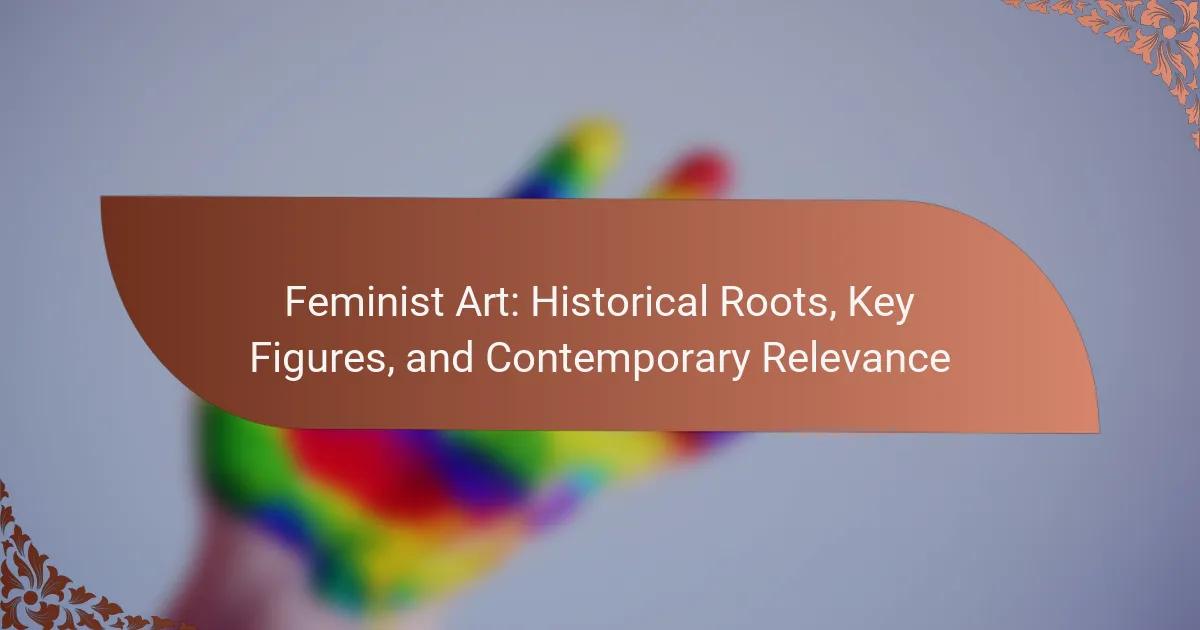Feminist art challenges traditional gender roles and highlights women’s experiences, advocating for equality and social critique. This article explores its historical roots, key figures like Judy Chicago and Barbara Kruger, and its contemporary relevance in addressing intersectionality and representation. Additionally, it examines the evolving themes and challenges faced by feminist artists today.
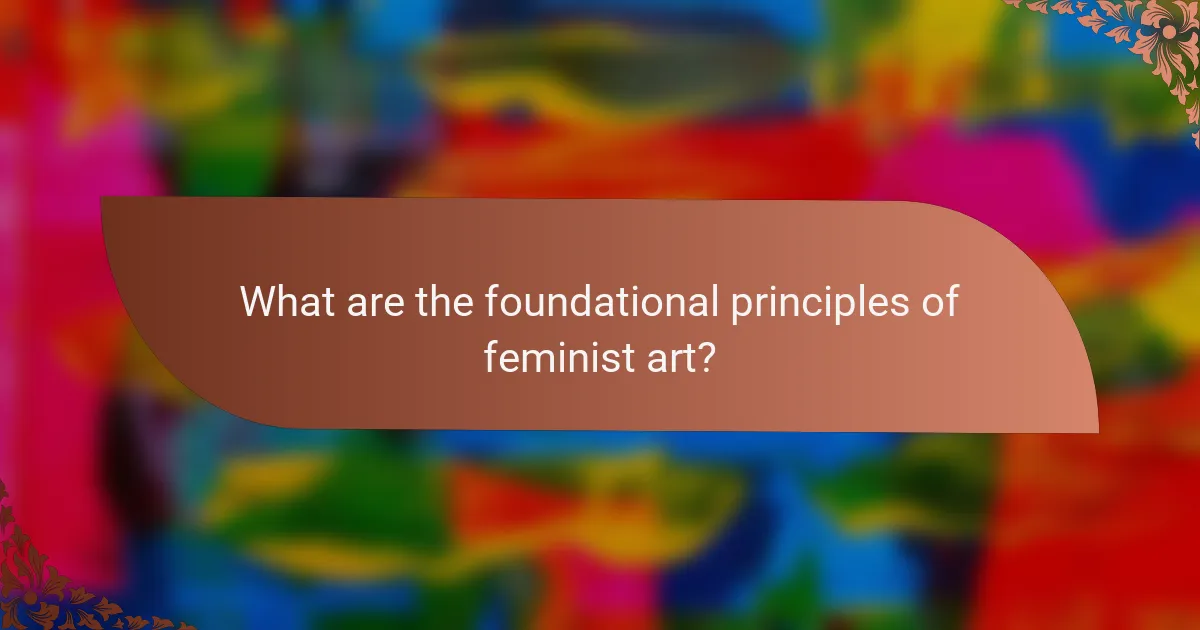
What are the foundational principles of feminist art?
Feminist art is grounded in principles of equality, empowerment, and social critique. It seeks to challenge traditional gender roles and highlight women’s experiences. Key figures like Judy Chicago and Barbara Kruger have significantly shaped this movement. Contemporary feminist art remains relevant by addressing ongoing issues such as intersectionality and representation in society.
How did feminist art emerge as a response to traditional art narratives?
Feminist art emerged as a response to traditional art narratives by challenging gender roles and promoting women’s perspectives. In the 1960s and 1970s, artists like Judy Chicago and Barbara Kruger highlighted the absence of women in art history. This movement sought to redefine artistic expression by incorporating themes of identity, sexuality, and social justice. Feminist artists aimed to dismantle patriarchal structures, asserting that personal experiences are valid subjects for art. Their work continues to influence contemporary discussions on gender and representation in the art world.
What role does intersectionality play in feminist art?
Intersectionality enriches feminist art by addressing diverse identities and experiences. It highlights how race, class, gender, and sexuality intersect, shaping individual perspectives. This approach fosters inclusivity, allowing marginalized voices to emerge in the art world. Key figures like bell hooks and Audre Lorde have emphasized this complexity, urging artists to reflect on their multifaceted identities. Contemporary feminist art often incorporates intersectional themes, challenging traditional narratives and promoting social justice.
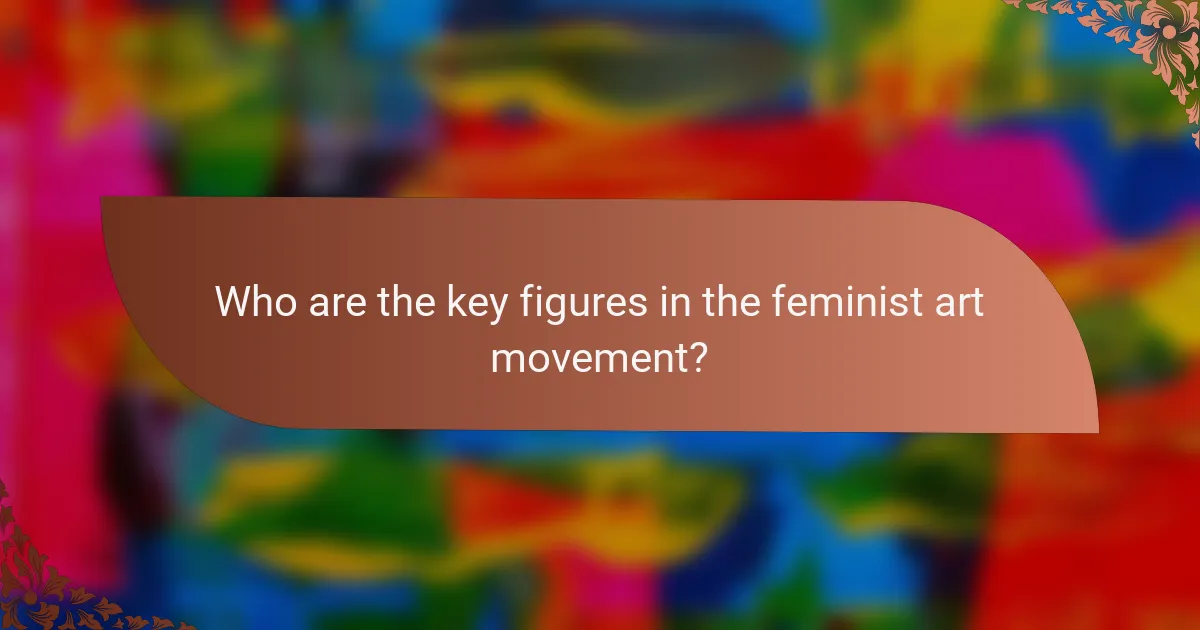
Who are the key figures in the feminist art movement?
Key figures in the feminist art movement include Judy Chicago, Barbara Kruger, and Cindy Sherman. These artists challenged traditional art narratives and highlighted women’s experiences. Judy Chicago’s “The Dinner Party” is a landmark installation celebrating women’s contributions to history. Barbara Kruger uses text and imagery to critique societal norms. Cindy Sherman is known for her conceptual portraits that explore identity and representation. Each artist has significantly influenced contemporary discussions on gender and art.
What contributions did Judy Chicago make to feminist art?
Judy Chicago significantly advanced feminist art through her groundbreaking works and advocacy. She is best known for “The Dinner Party,” which celebrates women’s contributions to history and culture, featuring 39 place settings for notable women. Chicago’s work often challenges traditional gender roles and highlights women’s experiences, making her a pivotal figure in the feminist art movement. Her teaching and public engagement have inspired countless artists to explore gender and identity in their work, solidifying her legacy in contemporary art.
How did the Guerrilla Girls challenge the art establishment?
The Guerrilla Girls challenged the art establishment by exposing gender and racial inequalities in the art world. They utilized provocative posters and public performances to raise awareness about the underrepresentation of women and artists of color. Their bold tactics included using humor and anonymity to criticize institutions that perpetuated discrimination. As a result, they sparked conversations about inclusivity and equity in the arts, influencing both feminist art movements and broader discussions on representation. This unique approach has solidified their role as key figures in feminist art history.
Which contemporary artists are reshaping feminist art today?
Contemporary artists reshaping feminist art include Jenny Holzer, Kara Walker, and Cindy Sherman. These artists challenge societal norms and highlight issues like identity, power, and gender. Holzer uses text-based art to provoke thought, while Walker’s silhouettes address race and history. Sherman’s photography critiques female representation in media. Their unique approaches contribute to the evolving dialogue of feminist art today.
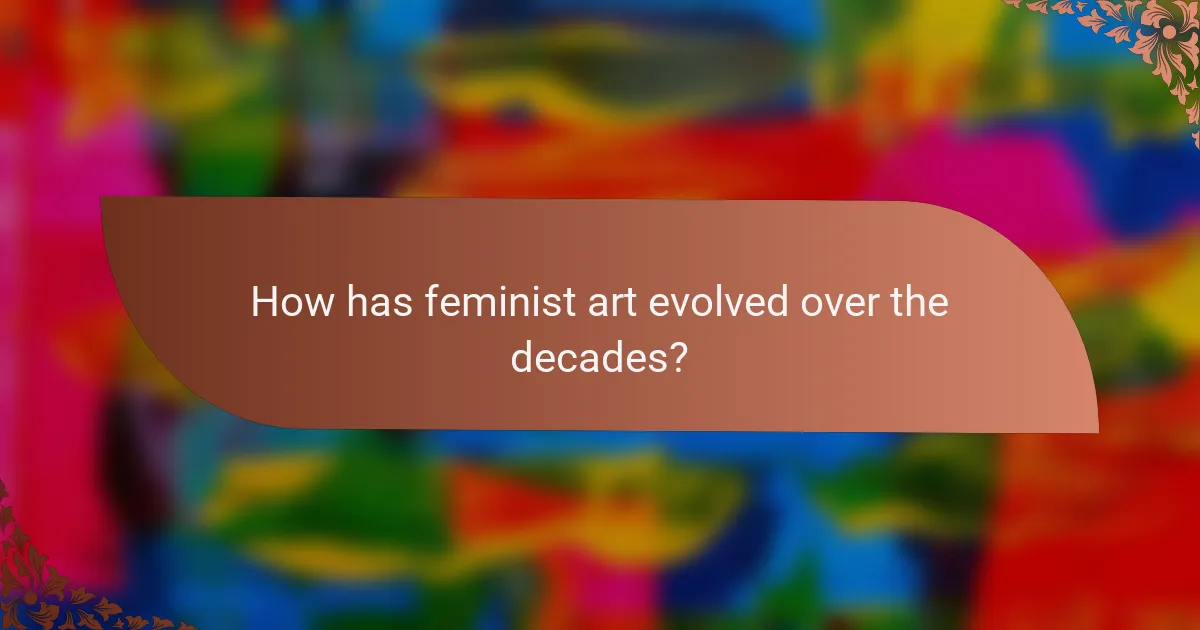
How has feminist art evolved over the decades?
Feminist art has evolved significantly since the 1960s, reflecting changing societal norms and gender politics. Initially rooted in the women’s liberation movement, it challenged traditional representations of women in art. Key figures like Judy Chicago and Cindy Sherman pioneered new forms of expression, emphasizing personal narratives and identity. In contemporary contexts, feminist art continues to address intersectionality and inclusivity, engaging with diverse voices and experiences. This evolution showcases the ongoing relevance of feminist perspectives in the art world.
What were the major milestones in feminist art during the 1970s?
Major milestones in feminist art during the 1970s include the establishment of feminist art movements, the creation of influential artworks, and the formation of women-centered art spaces. Key events were the first Feminist Art Show in 1972 and the founding of the Womanhouse project in 1972, which showcased women’s experiences. Prominent figures like Judy Chicago and Miriam Schapiro emerged, producing groundbreaking works that challenged traditional gender roles. These milestones significantly shaped the discourse around gender and art, promoting visibility and recognition for women artists.
How did the 1990s redefine feminist art practices?
The 1990s redefined feminist art practices by emphasizing intersectionality and diverse voices. Artists began to challenge traditional narratives and explore identity through various mediums. This decade saw the rise of key figures like Judy Chicago and the incorporation of multimedia, which expanded the scope of feminist expression. The focus shifted towards inclusivity, addressing race, class, and sexuality, thus enriching the feminist art dialogue. As a result, contemporary feminist art continues to reflect these complex intersections, making it relevant in today’s cultural landscape.
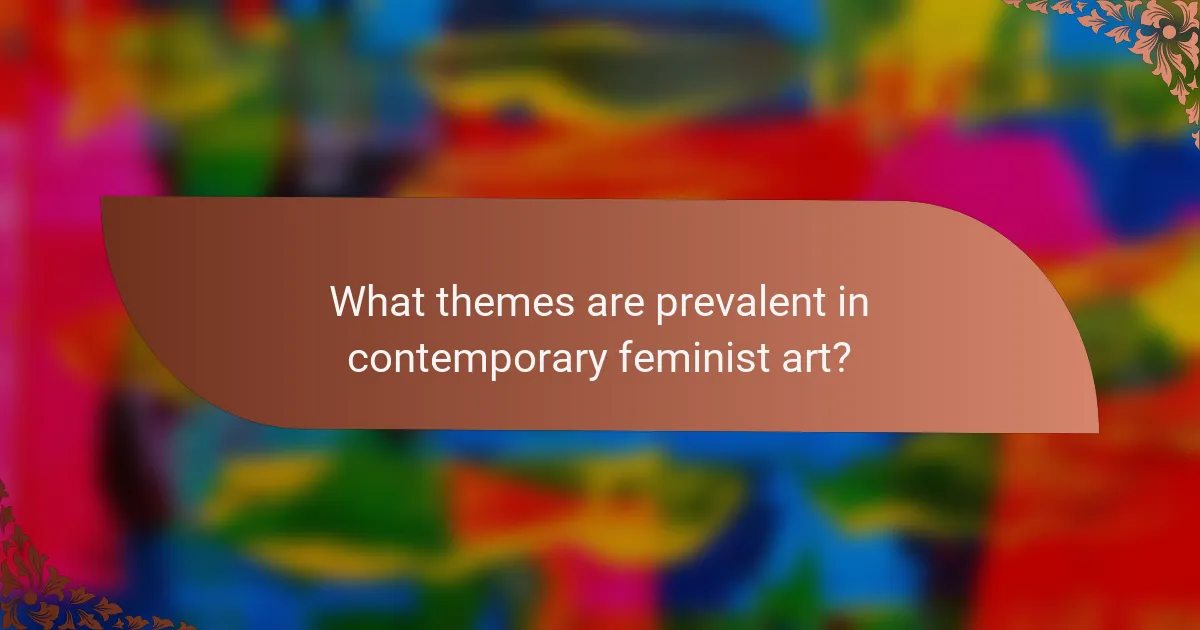
What themes are prevalent in contemporary feminist art?
Contemporary feminist art frequently explores themes of identity, representation, and empowerment. Artists address intersectionality, examining how race, class, and gender intersect in societal structures. The body is a central motif, challenging traditional norms and celebrating diversity. Additionally, many works critique patriarchy and advocate for social justice, reflecting ongoing struggles for equality. This art form remains relevant, inspiring dialogue and activism in today’s cultural landscape.
How does feminist art address issues of identity and representation?
Feminist art powerfully addresses issues of identity and representation by challenging traditional narratives. It emphasizes diverse female experiences, advocating for visibility and inclusion. Artists like Judy Chicago and Frida Kahlo explore personal and collective identities, reshaping cultural perceptions. Contemporary feminist art often critiques societal norms, using various mediums to amplify marginalized voices. This evolution reflects ongoing dialogues about gender, race, and sexuality, making feminist art relevant in today’s discourse.
What is the significance of body politics in feminist art?
Body politics in feminist art is significant as it challenges societal norms and promotes women’s agency. This movement emphasizes the representation of women’s bodies in art, highlighting issues like objectification and autonomy. Key figures, such as Judy Chicago and Cindy Sherman, use their work to address these themes. Their art fosters dialogue about identity, power, and the female experience, reinforcing the relevance of feminist perspectives in contemporary society.
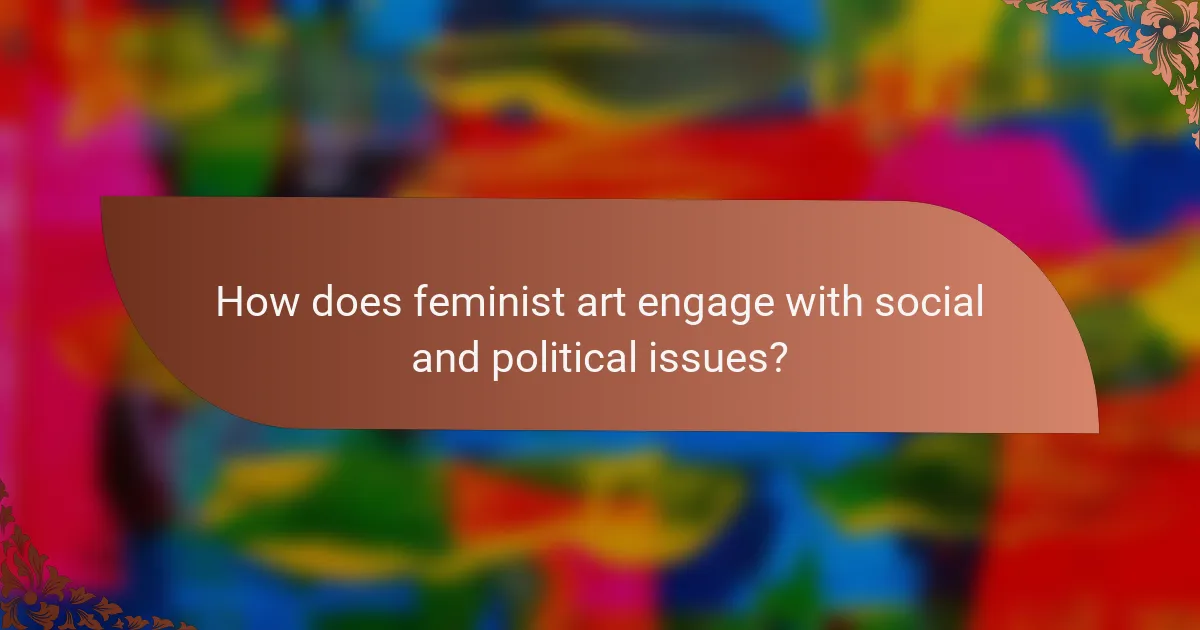
How does feminist art engage with social and political issues?
Feminist art actively engages with social and political issues by challenging gender norms and advocating for equality. This art movement emerged from historical contexts of women’s rights activism and has evolved to address contemporary societal concerns. Key figures like Judy Chicago and Barbara Kruger use their work to critique patriarchy, highlight women’s experiences, and promote social change. Feminist art remains relevant today, addressing issues such as body autonomy, representation, and intersectionality, demonstrating its ongoing impact on cultural discourse.
What impact has feminist art had on activism and social movements?
Feminist art has significantly influenced activism and social movements by challenging societal norms and promoting gender equality. It has provided a platform for marginalized voices, fostering dialogue and awareness around issues like reproductive rights and violence against women. Key figures, such as Judy Chicago and Barbara Kruger, have utilized their art to provoke thought and inspire action. Contemporary feminist artists continue to engage with social justice themes, ensuring that feminist discourse remains relevant and impactful. This ongoing evolution highlights the unique attribute of feminist art as a catalyst for change in various movements.
How do feminist artists use their work to address systemic inequalities?
Feminist artists use their work to challenge systemic inequalities by highlighting women’s experiences and advocating for social justice. They employ various mediums to confront issues like gender-based violence, wage disparity, and representation. For example, artists like Judy Chicago and Kara Walker create provocative pieces that spark dialogue and raise awareness. Their art often incorporates personal narratives, making systemic issues relatable and urgent. Additionally, contemporary feminist art movements emphasize intersectionality, addressing how race, class, and sexuality intersect with gender in the fight against oppression.
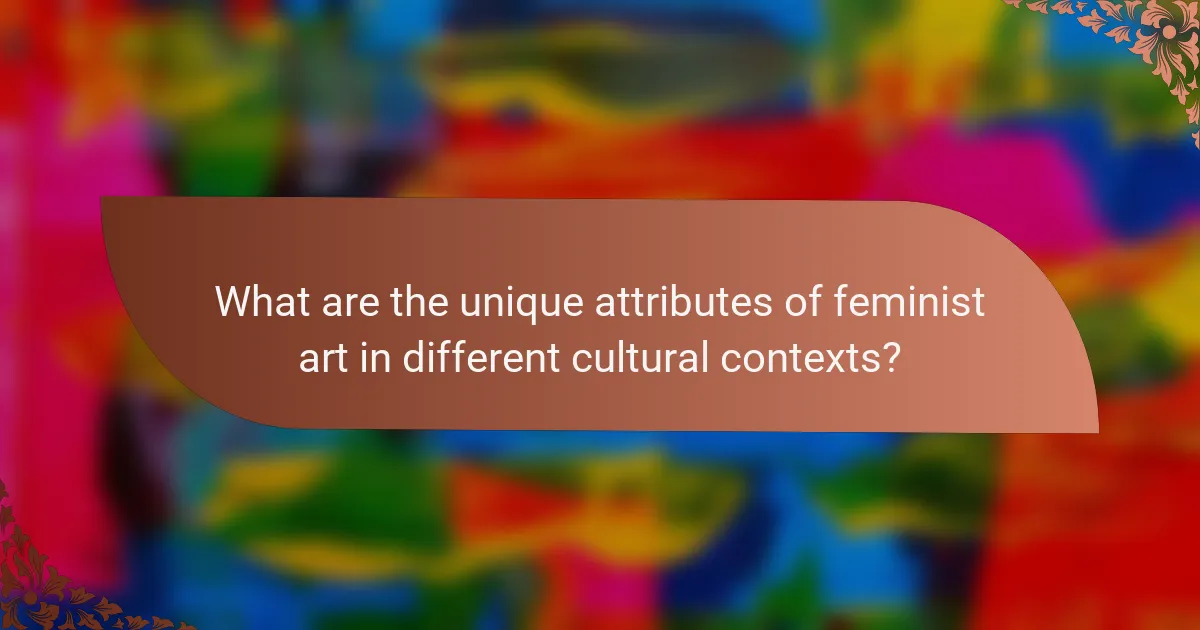
What are the unique attributes of feminist art in different cultural contexts?
Feminist art exhibits unique attributes influenced by cultural contexts, including diverse themes, techniques, and societal critiques. In Western contexts, feminist art often emphasizes individual empowerment and challenges patriarchal structures. In contrast, feminist art in non-Western cultures may focus on communal identity and intersectionality, addressing issues like colonialism and globalization. The use of traditional materials and methods can also vary significantly, reflecting local heritage and cultural narratives. This diversity enriches the global feminist art movement, showcasing how cultural backgrounds shape artistic expression and feminist discourse.
How does feminist art manifest in various global regions?
Feminist art manifests differently across global regions, reflecting local cultures and social issues. In the United States, feminist art often critiques patriarchy and promotes gender equality through bold installations and performances. In Latin America, artists like Frida Kahlo use personal narratives to address identity and body politics. European feminist art frequently explores intersectionality, emphasizing race and class alongside gender. In Africa, artists highlight colonial histories and contemporary struggles, illustrating resilience and empowerment. Each region’s manifestation of feminist art showcases unique attributes shaped by historical and cultural contexts.
What role do local narratives play in shaping feminist art?
Local narratives significantly influence feminist art by reflecting cultural contexts and personal experiences. These narratives provide a framework for artists to challenge societal norms and address issues specific to their communities. For example, regional histories and struggles shape the themes and aesthetics of feminist artworks, making them more relatable and impactful. The integration of local stories fosters a sense of identity, allowing artists to connect deeply with their audience. This localized approach enriches the broader feminist discourse by introducing diverse perspectives and experiences.
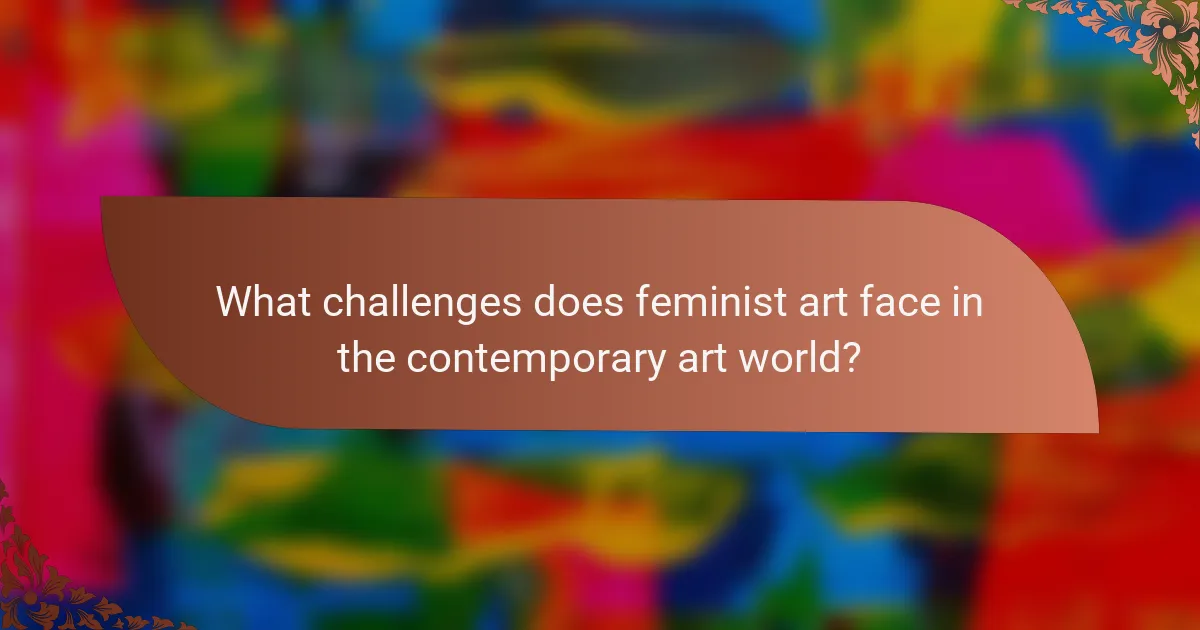
What challenges does feminist art face in the contemporary art world?
Feminist art faces several challenges in the contemporary art world, including marginalization, funding disparities, and gender bias. Many feminist artists struggle to gain visibility in mainstream galleries, which often prioritize male artists. Additionally, the art market frequently undervalues works by women, impacting their financial support and opportunities. This unique attribute of economic inequality continues to hinder the growth and recognition of feminist art. As a result, feminist artists must navigate a landscape that often overlooks their contributions and relevance.
How do market dynamics affect the visibility of feminist artists?
Market dynamics significantly influence the visibility of feminist artists by shaping audience engagement and platform accessibility. Economic factors, such as funding and sponsorship, affect the promotion of feminist art. Additionally, cultural trends influence public interest and acceptance. The rise of digital media has enhanced visibility, allowing diverse voices to reach broader audiences. However, market saturation can dilute individual recognition, making it challenging for feminist artists to stand out. As a result, the intersection of market dynamics and feminist art creates both opportunities and obstacles in achieving widespread visibility.
What barriers do feminist artists encounter in gaining recognition?
Feminist artists face significant barriers in gaining recognition, including systemic sexism, lack of representation, and institutional biases. Many art institutions prioritize male artists, leading to underrepresentation of female voices. Additionally, societal norms often devalue women’s contributions to art. This results in fewer opportunities for exhibitions and funding. The historical context of feminist art further complicates recognition, as it challenges traditional narratives and often confronts established power structures.
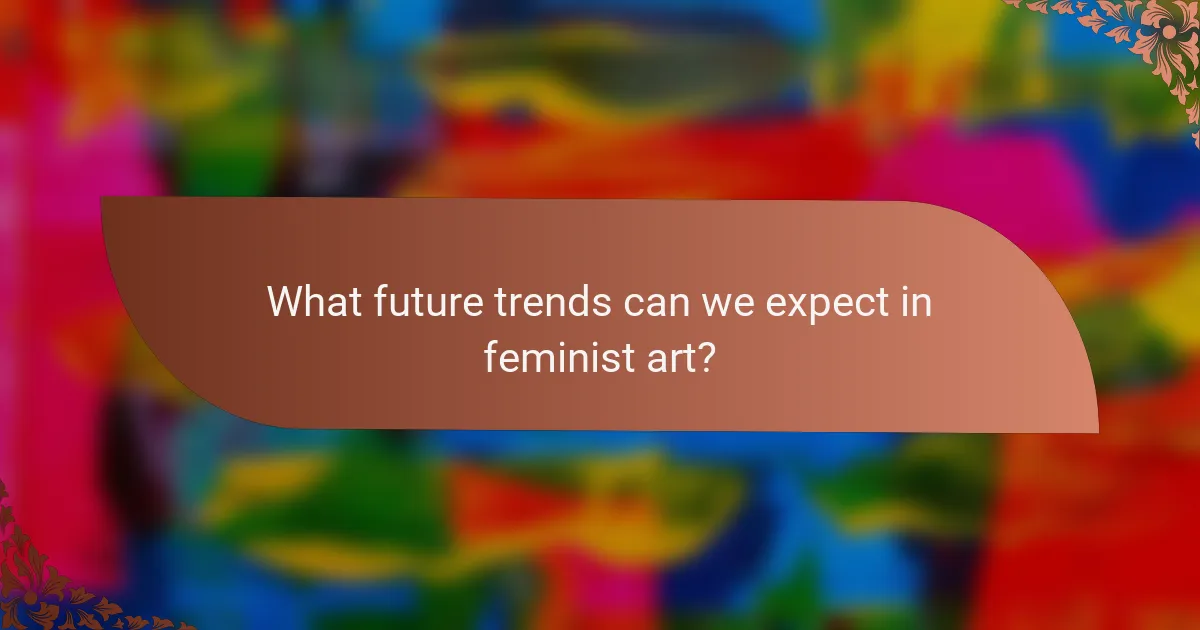
What future trends can we expect in feminist art?
Feminist art will increasingly embrace digital platforms, intersectionality, and global perspectives. Artists will leverage technology to challenge traditional narratives and engage diverse audiences. The focus will shift towards collaboration and community-driven projects, fostering inclusivity. Additionally, themes of social justice and environmentalism will play a significant role, reflecting contemporary societal issues.
How are emerging technologies influencing feminist art practices?
Emerging technologies significantly influence feminist art practices by enhancing creativity and accessibility. Digital tools enable artists to explore new mediums, such as virtual reality and digital installations, fostering innovative expressions of feminist themes. Additionally, social media platforms amplify visibility, allowing diverse voices to reach broader audiences. The use of technology also facilitates collaborative projects, breaking traditional barriers in art production. As a result, contemporary feminist art continuously evolves, reflecting the dynamic interplay between technology and social issues.
What strategies can feminist artists adopt to enhance their impact?
Feminist artists can enhance their impact by embracing collaborative projects, utilizing social media for outreach, and engaging in community activism. These strategies foster connections and amplify voices.
Collaboration allows artists to combine resources and reach broader audiences. Social media platforms enable direct interaction with supporters and art enthusiasts, increasing visibility. Community activism connects art to social issues, making it more relevant and impactful.
Additionally, exploring diverse mediums can attract varied audiences. For instance, performance art can evoke stronger emotional responses. By integrating these strategies, feminist artists can create meaningful dialogues and inspire change.
What best practices should artists follow to promote feminist art effectively?
Artists should engage audiences through social media, collaborate with feminist organizations, and host community events. These strategies enhance visibility and foster dialogue around feminist art. Utilizing platforms like Instagram can showcase artwork and connect with a broader audience. Collaborating with established feminist figures can lend credibility and attract attention. Hosting workshops or discussions can create a space for interaction and education, emphasizing the relevance of feminist art today.
